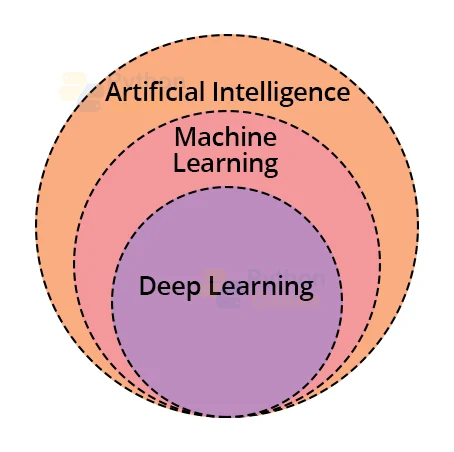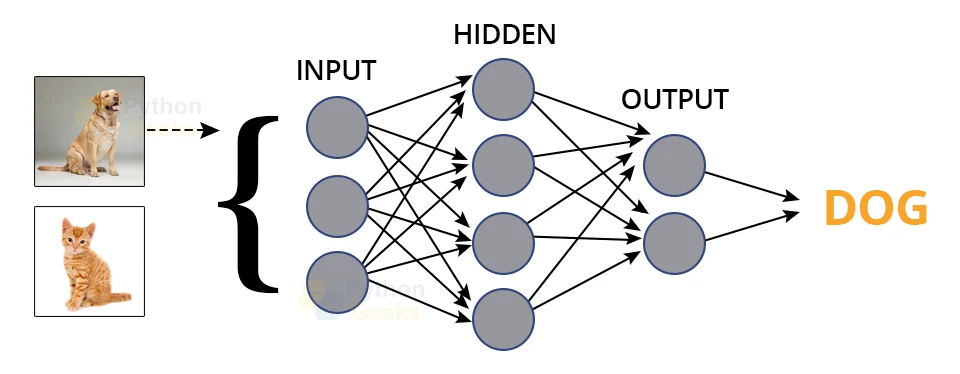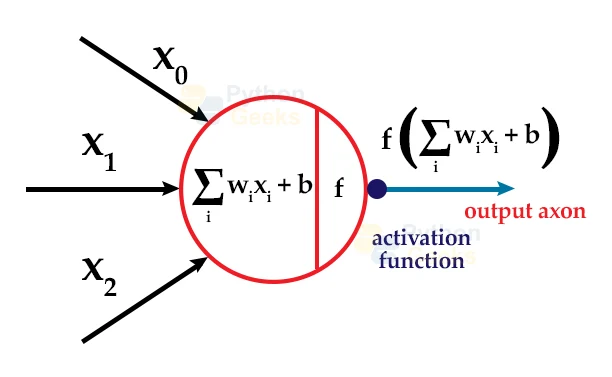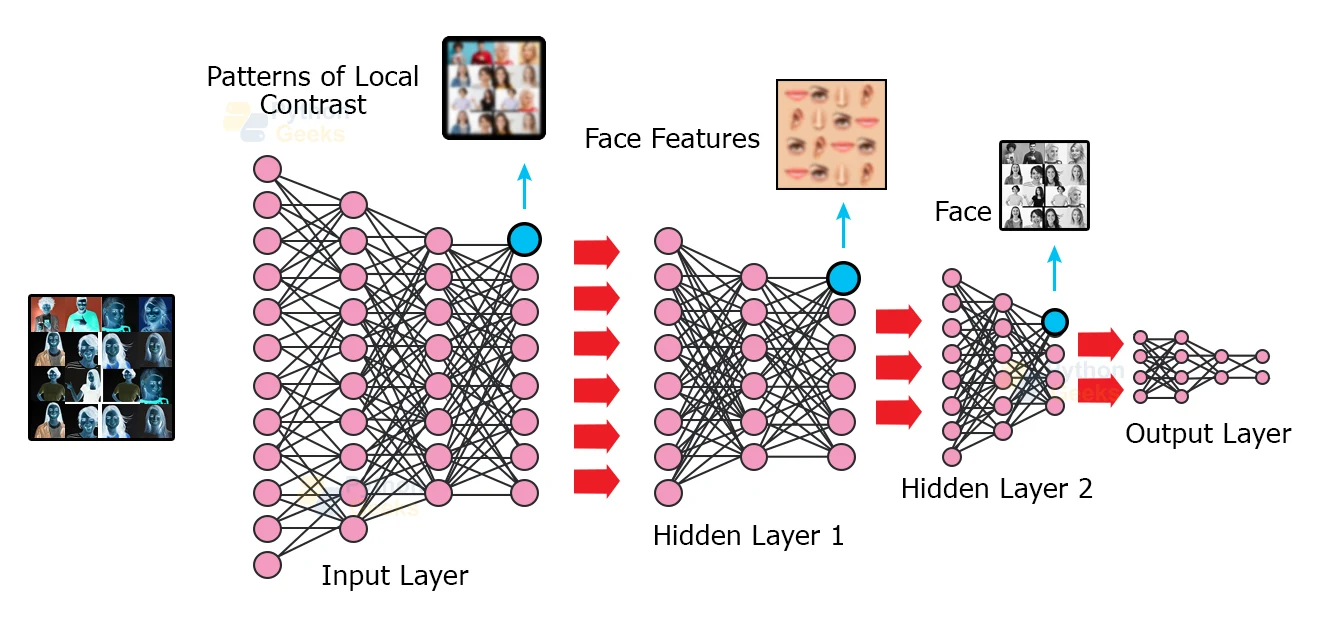Introduction to Deep Learning
Now that you are familiar with the various Neural Networks like Convolutional Neural Networks, Recurrent Neural Networks, Artificial Neural Networks, their applications and their architectures with a deep insight into the way they work. Let us now dig deep into this topic and learn about another interesting topic that is buzzing nowadays- Deep Learning.
You must have heard the term Deep Learning a million times now if you have an interest in the field of Artificial Intelligence. As an astonishing fact, Google faces an average of 186,000 queries on a daily basis that are about Deep Learning! Subsequently, we conclude that though Deep Learning is a trending technology, there isn’t much insight in people regarding what actually the buzz is all about.
PythonGeeks has got you covered. In this article, PythonGeeks will help you learn about the basics of Deep Learning, which will cover the introduction, working and some real-life applications of the technology. So, let’s dive straight into the introduction section to learn about the basics.
What is Deep Learning?
In technological terms, Deep Learning is a subset of Machine Learning which makes use of mathematical functions and logic to map inputs to the outputs. In order to achieve so, the technology tends to make use of functions that try to extract non-redundant information or patterns from the data. This enables the algorithm to decipher an accurate relationship between the input and the output.
In conventional programming, we used to combine the input and some set of rules in order to achieve the desired output. However, in Deep Learning, the input and output correlate to the rules themselves. Modern-day Deep Learning models make use of Neural Networks to extract information to decrypt a relationship between the input, output, and the patterns they form.
These so-called Neural Networks are nothing but just a set of mathematical functions that we stack on top of each other. We arrange these functions in the form of layers which gives them a sense of depth associated with them. The depth associated with these layers is what gives the technology its name as Deep Learning. In a broader sense, Deep Learning is just a part of Artificial Intelligence, which smartly blends the combination of hardware and software to solve the tasks with human-like intelligence.
Deep Learning was first coined in the late 1980s. However, it recently became popular in use because of two major factors:
- It needs an enormous amount of labeled data (trained data that we used earlier to achieve the output)
- It also requires a substantial amount of computational power like high-performance GPUs.
As we have stated earlier, the heart of Deep Learning lies in Neural Networks. We have seen in the previous articles about the various Neural Networks, their working, and architecture. The core principle behind these Neural Networks was that they tend to replicate the working of biological neural networks. These networks make Deep Learning an essential part of major algorithms like classification, clustering, regression, and much more.
Now that we know the basics of Deep Learning, let us look at the way a Deep Learning model will work.
Why does Deep Learning Matter?
As we have seen in the earlier sections, Deep Learning models require high-performance resources and enormous amounts of data to achieve the results. Due to these requirements, the results that we attain from these models are quite accurate and help us in the efficient processing of the data. This accuracy is quite useful even it comes to delivering results that require high safety and precision rates like driver-less cars.
With the exponential increase in the arena of Deep Learning, these models have evolved to a point that they can outperform in areas of human-error-prone areas.
How does Deep Learning Work?
The core of any Deep Learning Model is the use of a Neural Network. As seen in the previous articles about the various Neural Networks, we came across the architecture which helps the working of these Networks.
Developers fabricate the basic structure of each Neural Network using three layers- an input layer, hidden layers, and output layer. These layers are nothing but a mesh of artificially synthesized neurons that are closely interconnected. Each one of these neurons or nodes is based on a simple mathematical function which is usually linear in nature. This function helps the model in extracting substantial information from the data and mapping the input to the most accurate output.
The data flow of this architecture is unidirectional, which means that data can flow in a single direction only. The flow of information starts at the input layer.
1. Input Layer
We feed the information to the input layer in the form of encrypted text, characters, images, or audio files. Each neuron of the input layer consumes this data and transfers it to the next layer.
2. Hidden Layers
The next layer in the architecture is the hidden layer. The name of this layer is a hidden layer because the parameters like weights and biases for the neurons of this layer are not known. The neural network can have more than one hidden layer. These hidden layers tend to extract more features from the data passed from the input layer and decipher a linear function to map the input with the desired output. Since the weights and biases are unknown, different hidden layers add different parameters to the data which results in the yield of different outputs.
3. Output Layer
The output of the hidden layers is then transferred to the final layer- the output layer. We yield the desired output at this layer from the extracted data at the hidden layer. From the extracted data, the output layer tends to yield results like pattern recognition, prediction, sample generation, and much more.
This whole process of obtaining the results by feeding the data to the input layer and achieving the results from the output layer with a unidirectional flow of data is known as forward propagation.
There is one more process which the algorithms like gradient descent use, called the backpropagation process. In this process, the algorithm tends to calculate errors by comparing the difference between the acquired output and the output that we expected from the process. Then the algorithm tries to minimize or nullify the error by fine-tuning or altering the weights and biases by traversing back through the layers.
With the help of these two processes, Neural Networks can achieve finely accurate results with reduced errors. With the help of iterative processes, the Neural Networks can achieve results that are significantly accurate.
Now that we know about the working of the Neural Networks, let us look at some of the hindrances that are yet to be resolved in Deep Learning. Learning about these challenges will help you to build a solution in the future to overcome these issues.
Deep Learning Use Cases
To understand the use case of Deep Learning, we will look at a small example. Consider, our input data is far greater than the capacity of the input layer.
1. Since the dimensions of the input data are quite high, we have to adjust the data in such a way that it matches the dimensionality of the input layer. In order to do this, it requires multiple sub-layers of perception to manage an entire lot of data.
2. The input layer also has the patterns that it receives from the output layer. This helps the input layer in identifying the edges of the images with the help of the contrasts.
3. The input data further traverses to the hidden layer 1. At this layer, more distinguishing features like eyes, nose, and other details are noted.
4. Consequently, the output of the hidden layer 1 with more distinguishing features traverses to hidden layer 2, where the layer identifies the whole face as one whole entity.
5. At last, this identified facial information traverses to the output layer. Here, the actual task of classification takes place on the basis of the dataset that we feed to the model earlier.
Challenges Before Deep Learning
1. Shortage of Trained Dataset
Deep Learning is one of the most data-driven approaches in Machine Learning. It requires a huge amount of data for the recognition of patterns, structure, and relationships. A minor inconvenience or error in the data may lead to corruption of the process of learning of the Neural Network. Apart from this, if sufficient data is not available, then the results of the network may not be near to accurate or sometimes also be misleading. The main requirement for the proper functioning of this network is the availability of a vast trained dataset.
2. The complexity of the model
Fabricating a deep learning model can be quite tiresome sometimes. It is often a trial-and-error process. A minimalistic model may qualify as underfitting for accurate result handling. This can also lead to a shortage of trained data for the neural network. A more complicated model may prove to overfit the Deep Learning Model. With an overfit model, the algorithm will not be able to generalize the results for other testing data sets. The complexity to develop a perfect model with enough trained data is quite high.
3. Inability to Multitask
Deep Learning Models are not able to multitask. These models are capable of producing an accurate result on the targeted data, which means that the model will not produce accurate results when the data is unseen. As an example, consider a model that is trained with the data for cats and dogs. With this model, we cannot gain accurate results if we feed the model with the data for men and women. Furthermore, tasks that require logical reasoning and general intelligence are beyond the scope of the current Deep Learning models.
4. Hardware Dependency
Deep Learning models cost a lot for their maintenance and computation. As mentioned earlier, they require high-performance GPUs and are not able to work with simple CPUs. Though using high-performance GPUs and TPUs reduces the time crunches for the accuracy of the results, they are quite expensive and require a huge amount of energy resources.
Choosing Between Deep Learning and Machine Learning
As we have witnessed many times, Machine Learning models are capable of catering to our needs in a very efficient way. We can choose the perfect Machine Learning Model from the plethora of models available according to our dataset, training purpose, and the type of problem we encounter. However, Deep Learning models need a huge dataset, high-performance GPUs, and other resources, in general, to train the model effectively.
The choice between Machine Learning and Deep Learning can be quite confusing. However, there is one deciding factor that can help us in choosing the right technology. Before training any of the model, we need to make sure of the availability of high-performance GPUs and well-trained data. If you lack any of them, it is advisable that you choose the Machine Learning model over Deep Learning. Deep Learning models usually handle problems that are more complex and require high-power GPU and a huge dataset.
Deep Learning Applications
1. Self-Driving Vehicles
Self-Driven Vehicles are quite a trending topic for developers nowadays. Developing a vehicle that can automate its working without human interference may have sounded like a miracle in the past. However, with Deep Learning, we can now conceptualize the working of a model which will detect obstacles in the path and guide the vehicle accordingly.
2. Pre Natal Care
Deep Learning techniques take a huge span of applications in pre-operative diagnosis. Countries like the USA and Australia use these models for image recognition and sign interpretation.
3. Weather Forecasting
Deep Learning models along with geostationary satellites help in the detection of natural calamities. Other techniques are useful in the prediction of cyclone activities
4. Fraud News Detection
There is still scope for the aggregation of the news to filter out all the negative news from a reader’s feed. However, with extensible use of Deep Learning in the aggregation of News items, we can personalize the user’s reading experience. On the other hand, Fraud News Detection is an essential use of Deep Learning to ensure online security.
Today, we have a plethora of publishing houses, and each day these publications produce millions of news. It becomes quite difficult for the readers to figure out fake news from the abundance of new items. Deep Learning models can now help in customizing the news items according to the reader’s interest. This reduces the chance of encountering fake news.
5. Law enforcement
We can use Deep learning algorithms to analyze and learn from transactional data to identify dangerous patterns that indicate possible fraudulent or criminal activity. Apart from this, Speech recognition, computer vision, and other deep learning applications can improve the efficiency and effectiveness of investigative analysis by extracting patterns and evidence from sound and video recordings, images, and documents, which helps law enforcement analyze large amounts of data with greater speed and accuracy.
6. Financial services
Financial institutions regularly use predictive analytics. The major use of Deep Learning in Financial Services is to drive algorithmic trading of stocks, assess business risks for loan approvals, detect fraud. It also helps in managing credit and investment portfolios for clients.
Apart from these, the Deep Learning models are deployed in various areas of AI and ML, like virtual assistants, healthcare while the list goes on.
Conclusion
To conclude this article, we can certainly say that Deep Learning will certainly be amongst the top trending technologies in the coming years as well as the present. We came across the basics of these models and what actually one means by the term “Deep Learning”. We also came across the working of these models in great detail.
Apart from these, PythonGeeks also helped you in knowing the current drawbacks of the technology. These could help you for the future development of the technology. You also saw some of the real-life applications of Deep Learning in the industrial world. Hope that you have now gained an understanding of Deep Learning through this PythonGeeks article.



